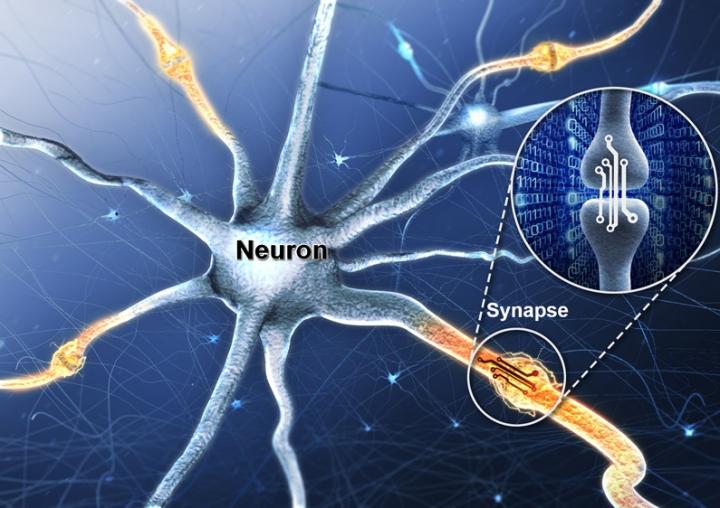Artificial synaptic device simulating the function of human brain

Representation of neurons and synapses in the human brain. The magnified synapse represents the portion mimicked using solid-state devices. Credit: Daegu Gyeongbuk Institute of Science and Technology (DGIST)
Synapses are where axons and dendrites meet so that neurons in the human brain can send and receive nerve signals; there are known to be hundreds of trillions of synapses in the human brain.
This chemical synapse information transfer system, which transfers information from the brain, can handle high-level parallel arithmetic with very little energy, so research on artificial synaptic devices, which mimic the biological function of a synapse, is under way worldwide.
Dr. Lee's research team, through joint research with teams led by Professor Gyeong-Su Park from Seoul National University; Professor Sung Kyu Park from Chung-ang University; and Professor Hyunsang Hwang from POSTEC, developed a high-reliability artificial synaptic device with multiple values by structuring tantalum oxide – a trans-metallic material – into two layers of Ta2O5-x and TaO2-x and by controlling its surface.
The artificial synaptic device developed by the research team is an electrical synaptic device that simulates the function of synapses in the brain as the resistance of the tantalum oxide layer gradually increases or decreases depending on the strength of the electric signals. It has succeeded in overcoming durability limitations of current devices by allowing current control only on one layer of Ta2O5-x.
In addition, the research team successfully implemented an experiment that realized synapse plasticity, which is the process of creating, storing, and deleting memories, such as long-term strengthening of memory and long-term suppression of memory deleting by adjusting the strength of the synapse connection between neurons.
The non-volatile multiple-value data storage method applied by the research team has the technological advantage of having a small area of an artificial synaptic device system, reducing circuit connection complexity, and reducing power consumption by more than one-thousandth compared to data storage methods based on digital signals using 0 and 1 such as volatile CMOS (Complementary Metal Oxide Semiconductor).
The high-reliability artificial synaptic device developed by the research team can be used in ultra-low-power devices or circuits for processing massive amounts of big data due to its capability of low-power parallel arithmetic. It is expected to be applied to next-generation intelligent semiconductor device technologies such as development of artificial intelligence (AI) including machine learning and deep learning and brain-mimicking semiconductors.
Dr. Lee said, “This research secured the reliability of existing artificial synaptic devices and improved the areas pointed out as disadvantages. We expect to contribute to the development of AI based on the neuromorphic system that mimics the human brain by creating a circuit that imitates the function of neurons.”
###
Meanwhile, this research outcome was published on Monday July 23, 2018 in the online edition of ACS Applied Materials and Interfaces, an international journal in the field of material science. It will also be published as a cover article in the August edition.
For more information, contact:
Director Myoung-Jae Lee
Intelligent Devices and Systems Research Group
Daegu Gyeongbuk Institute of Science and Technology (DGIST)
E-mail: myoungjae.lee@dgist.ac.kr
Associated Links
Research Paper in the online edition of ACS Applied Materials and Interfaces
https:/
Journal Reference
Myoung-Jae Lee, Gyeong-Su Park, Sung Kyu Park, Hyunsang Hwang, et al., “Reliable Multivalued Conductance States in TaOx Memristors through Oxygen Plasma-Assisted Electrode Deposition with in Situ-Biased Conductance State Transmission Electron Microscopy Analysis,” ACS Applied Materials and Interfaces July 2018.
Media Contact
All latest news from the category: Information Technology
Here you can find a summary of innovations in the fields of information and data processing and up-to-date developments on IT equipment and hardware.
This area covers topics such as IT services, IT architectures, IT management and telecommunications.
Newest articles

First-of-its-kind study uses remote sensing to monitor plastic debris in rivers and lakes
Remote sensing creates a cost-effective solution to monitoring plastic pollution. A first-of-its-kind study from researchers at the University of Minnesota Twin Cities shows how remote sensing can help monitor and…

Laser-based artificial neuron mimics nerve cell functions at lightning speed
With a processing speed a billion times faster than nature, chip-based laser neuron could help advance AI tasks such as pattern recognition and sequence prediction. Researchers have developed a laser-based…

Optimising the processing of plastic waste
Just one look in the yellow bin reveals a colourful jumble of different types of plastic. However, the purer and more uniform plastic waste is, the easier it is to…



